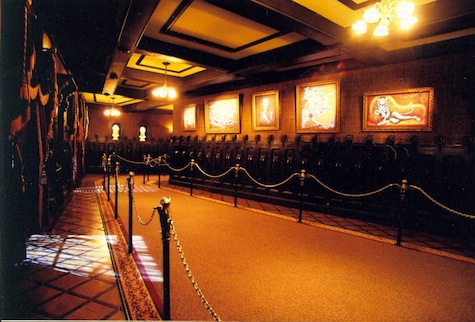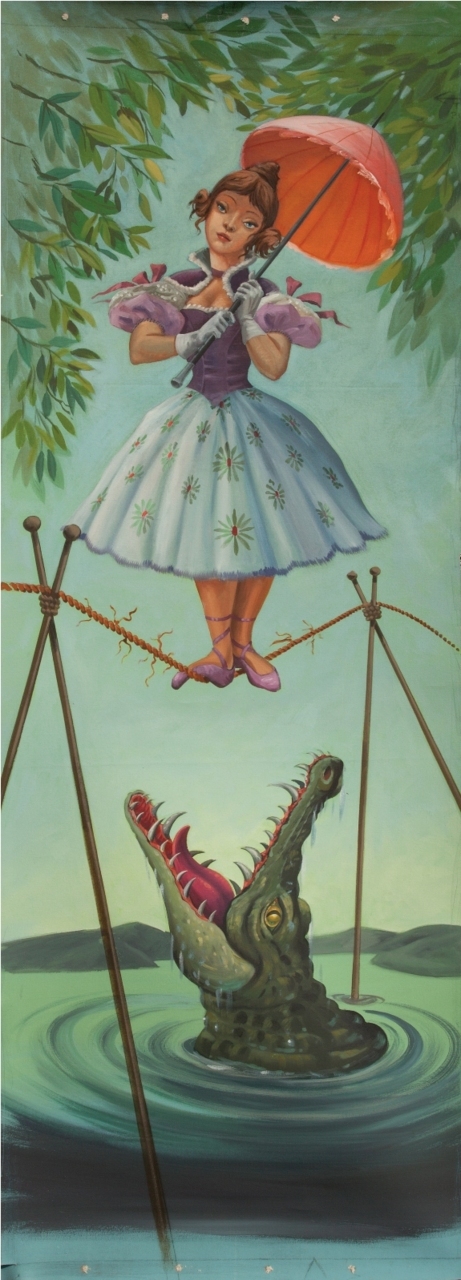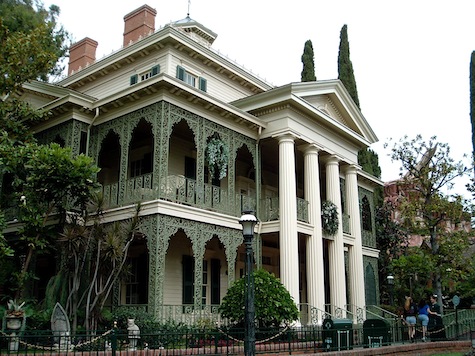The most remarkable thing about the Haunted Mansion in Disneyland has nothing to do with the ghosts. When I say “Haunted Mansion” in this post, I am referring specifically to the attraction at Disneyland in California, and not to the attraction’s other locations or to the (apparently dreadful) 2003 film.
When I visited Disneyland for the first time this spring, I looked askance at the Haunted Mansion. I assumed it would be either a sanitized, childlike fantasy or a gothic, Burton-esque nightmare. It would be overly branded with Disney characters, and it would either bore me or scare me, and I dislike being scared almost as much as I dislike being bored.
As it turns out, I overlooked something very critical, and I was not bored in the least. Because the Haunted Mansion is beautiful.
The Haunted Mansion is perhaps one of Disney’s best examples of artistry in attraction design. Disney’s brand is built in part upon a fanatical attention to detail. Although visiting Disneyland occasionally made me want to crawl out of my skin (that’s another post entirely, but let’s just say it rhymes with “schmacism”), it also inspired a great deal of artistic respect.

As it turns out, however, it’s a bit of a twisted road from the first idea to the attraction I saw this spring. The development of the Haunted Mansion was incredibly complicated, and plagued by very basic story questions. For example, was the ride supposed to be scary or funny? The mansion cycled through a number of designers, and was never actually approved in its final form by Walt Disney; he was skeptical about the ride at the beginning of development and didn’t live to see it open.
The idea for the mansion came from a simple sketch by art director Harper Goff, during the initial rendering and concept phase for Disneyland itself in 1955. (Harper Goff also art-directed Willy Wonka & the Chocolate Factory, and watching that movie after seeing Disneyland itself is a little eerie.)
The concept was then handed off to Imagineer Ken Anderson, who created a run-down, ramshackle building full of fantastical and extremely spooky effects; so spooky that the cleaning staff of the Disney offices refused to clean in the rooms where the effects were being developed. But Disney didn’t like the idea of a shabby building smack-dab in the middle of his beautiful park, and the outer concepts had to be redone. After being announced to the public in 1961, the project was put on hold while Walt Disney and his team focused on getting ready for the 1964 World’s Fair.
Walt Disney died in 1966. In the period between the fair and his death, Anderson left the project, and the Haunted Mansion’s development went through a confusing stage, as many different ideas and directions were piled on top of the original concept.
After Disney’s death, the project evolved, eventually opening in 1969 to mixed reviews from both the internal team, who were frustrated over the complicated development process, and park visitors, who had been hearing hype about the ride for the past 7 years. That said, the ride’s opening night brought record crowds, and over the years the Haunted Mansion has become something of a cult classic, inspiring a large and devoted fan base. One fan site describes the Haunted Mansion as a testament not to Disney himself, but to the team he put together, as prime example of their ability to continue creating to Disney’s standards after his death.
What were probably once viewed as problems with the ride now seem to be loved as character flaws. For example, The Haunted Mansion breaks down all the time. Or rather, it stops. For a few seconds, or a few minutes. Apparently this is sometimes mechanical, sometimes because the ride slows to load elderly guests, and sometimes because kids climb out of their seats. On my one ride, we stopped three times. My park buddy, who grew up near Disneyland and has been on the attraction many times, remembers it breaking down on almost every visit. Thankfully, the ride effects keep running even when the seats are stopped. Our seat was stuck in front of a chorus of singing gravestones, their faces projected from somewhere hidden beneath our feet onto smooth marble busts. If we’d sailed by them I might have remembered them simply as a neat effect and a momentary scrap of song, but sitting in front of them for five minutes meant that I became very interested in figuring out how they worked. (I’m still not sure.)
A lot of the delight of the Haunted Mansion is in trying to figure out how the tricks work. At one point the seats pass along a gallery that overlooks an empty ballroom. As we passed by, I watched as translucent, blue figures in rags appeared and began to dance below us. I remember leaning eagerly forward and saying “It’s a mirror!” (I’m pretty sure I was right about that one.)
The Haunted Mansion is surprising, textured, and focused on artistry and detail. This is not the soft, cuddly Disney I was expecting. The attraction exemplifies the entire experience of Disneyland: meticulously curated, happily weird, supported but not driven by established movie characters, and more than a little surreal. There’s no obligation for the ride to present an overarching narrative, so the characters vary in aesthetic from cartoonish to realistic, weaving hundreds of tiny stories together.
My favorite moment of the attraction is a good example of one of those tiny stories. As you enter the ride, you’re ushered into a large room with paintings on the walls. This was the first trick I figured out while I was there; the room is an enormous elevator. The paintings expand downward, so that previously idyllic scenes become dangerous and gruesome as you slowly travel down. A nice older man in a suit turns out to be standing on a keg of dynamite in his underwear. A happy woman holding a rose is actually sitting on her husband’s gravestone. And a young woman holding a parasol turns out to be standing on a tightrope above an alligator.

That young women clinched the ride for me, right from the very beginning. Through my wanderings on the internet, I was already familiar with the painting, and with the complex development of that character over several different versions of the piece. She’s a tiny character. She doesn’t appear in a Disney film or show up in any other rides. You see her for perhaps 30 seconds as you step inside the room, and that’s all. But she’s had so many iterations and interpretations over the years that there’s reams to be written just about her.
That’s the beauty of the Haunted Mansion. The details are dense, and behind every detail is a story. The ghosts aren’t particularly scary, but the stories they tell are dark. Dark, and funny, and beautiful.
Sara Eileen Hames is afraid of the dark.











I have always preferred the Haunted Mansion in Disneyland to the one in Disney World. If you ever have the chance to see both Mansions, they are clearly very different in design and execution. I think having to work within the limitations of a small repurposed space in the middle of an already constructed park required an ingenuity that really refined the conceptual design and the flow of both the traffic and the effects. The latter seem more subdued and there were parts (like the ballroom scene) that were downright beautiful. Same goes for the Pirates of the Carribbean ride in the different parks, for much the same reason.
Shortly before my wife died from leukemia, we took a family trip to Disneyland. After managing to hand our kids off to their aunt & uncle, my wife and I climbed aboud the Haunted Mansion and (finally free), started making out. We were quickly informed that this was a “family ride” and not a “family-making ride”. We giggled like teenagers through the rest of the experience.
I’m pretty sure that was the last time I really kissed her, and the Haunted Mansion remains a wonderful memory for me.
In addition to the frequent stoppages you describe, I’ve also had to actually get out of the car and walk out of the ride not once but twice. I’m sure the rational explanation, that the ride stops and breaks down often simply because it is very intricate, is the right one, but especially at this time of year, I prefer to think there’s another explanation.
I love the ballroom, and the room with “no windows and no doors,” but for me one of the most effective bits is the door with the knocker that keeps knocking. For some reason the sound of that knocker actually does make me shiver a little.
Thanks for pointing out the mansions are different in the different parks–I’ll check that out next time I am out west.
Weird, we went to Disneyworld a year after it opened, and I’d swear the Haunted mansion there was as you describe here. I distinctly remember the ballroom dancers. At the time, it was simply amazing, and it was also quite beautiful.
I’ve been on the Disneyland Haunted Mansion 3 or 4 times and it never broke down once! I don’t know if I’m lucky or I’ve been missing out…
Now when you break down in the “It’s a Small World” That is absolutely terrifying. I don’t think I ever got over it.
@shellywb disneyworld opened in 1971,
disneyland opened in 1955, and the Disneyland haunted mansion opened in 1969. The disneyworld version is a copy of the original at disneyland, with some differences.
The idea in this that really rings true for me is that the Haunted Mansion doesn’t have a clear, single narrative. I think that that’s the secret to its success (and also Pirates, before they ruined it with Jack Sparrow). You don’t want a clear narrative flow in a dark ride, because the riders will always see everything in different orders, for unpredictable amounts of time, and will eventually see everything repeat. You want something that gives the impression of a story behind it, but with enough pieces left out that everyone has to construct a narrative that can shift and change if you ride more than once (or many times more than once)!
@jeffs
Oh god yes, I was stuck in that ride for 55 minutes. Scarred me for life.
well…. the ride did have a narrative when it was first developed.
The hanged man in the room with no windows or no doors was the groom the bride in the attic was waiting for. Later the bride was changed to be the killer we see in the ride currently.
but it was a loose narrative and still remains fun to this day because of all the details.
Disney was a story teller. everything in the park has an idea of a narrative. That is what brings all the little pieces together into a great experience but the light touch is what makes it delighful.
Also the ride does not break down as much as it has to accommodate people who need both the omnimovers and the moving loading ramp stopped so they can get onto the ride and then off of the ride since loading and unloading are the same action. (stepping into and out of a moving vehicle from a moving platform) they are not just the elderly.